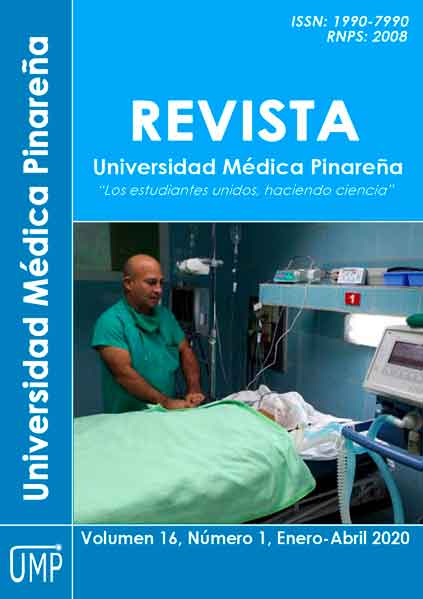Diagnostic value of R wave in aVL lead in left ventricular hypertrophy
Keywords:
Hypertrophy, Left Ventricular, Electrocardiography, Echocardiography, Heart Function Tests.Abstract
Introduction: left ventricular hypertrophy (LVH) is defined as the increase in the thickness of the wall or the interventricular septal portion (or both). This entity represents an important risk factor that is related to the increase in mortality. Its diagnosis is based on voltage criteria that become visible on the is based on voltage criteria that become visible on the electrocardiogram, such as that the R-wave voltage criterion in lead aVL (RaVL).
Objective: to evaluate the diagnostic utility of the R-wave voltage criterion in lead aVL (RaVL) for left ventricular hypertrophy.
Methods: an observational, analytical and cross-sectional study was conducted, where 127 patients were studied. Clinical and electrocardiographic variables were studied.
Results: left ventricular hypertrophy was identified by echocardiography in 69 % of patients. The voltage criterion of the R-wave in lead aVL (RaVL) had a low sensitivity (14,9 %), high specificity (92,5 %) and high positive predictive value (81,3%). The Odds ratio of the R-wave in lead aVL (RaVL) for concentric left ventricular hypertrophy was 0,85 while for the severe one it was 6,13.
Conclusions: the voltage criterion of the R-wave voltage in lead aVL (RaVL) was more useful to confirm the cases that in reality present left ventricular hypertrophy and not to deny such existence, but not to discriminate between both types of left ventricular hypertrophy. This criterion is very useful to detect severe forms of this entity.
Downloads
References
2. Guadalajara Boo JF. Entendiendo la hipertrofia ventricular izquierda. Arch. Cardiol. Méx. [Internet]. 2007 [citado 2019 Dic 10] ; 77( 3 ): 175-180. Disponible en: http://www.scielo.org.mx/scielo.php?script=sci_arttext&pid=S1405-99402007000300001&lng=es.
3. Hernández-del Río JE. Incidencia de hipertrofia ventricular izquierda en pacientes con eventos vasculares isquémicos cerebrales. Revista Médica MD [Internet]. 2014 [citado 2019 Dic 10]; 6 (1): 17-24. Disponible en: https://www.medigraphic.com/cgi-bin/new/resumen.cgi?IDARTICULO=53767
4. Suárez Conejero AM, Lemus Almaguer y, Meirelis Delgado DM, Otero Suárez M. Valor del electrocardiograma en el diagnóstico de hipertrofia ventricular izquerda de pacientes en hemodiálisis. CorSalud [Internet]. 2018 [citado 2019 Nov 20] ; 10( 1 ): 21-31. Disponible en: http://scielo.sld.cu/scielo.php?script=sci_arttext&pid=S2078-71702018000100004&lng=es.
5. Cooper J. Electrocardiography 100 years ago. Origins, pioneers, and contributors. N Engl J Med [Internet]. 1986 [citado 2019 Nov 15]; 315(7): 461–4. Disponible en: https://www.nejm.org/doi/pdf/10.1056/NEJM198608143150722
6. Lu N, Zhu JX Yang PG; Tan XR. Models for improved diagnosis of left ventricular hypertrophy based on conventional electrocardiographic criteria. BMC Cardiovasc Disord [Internet]. 2017 [citado 2019 Nov 10]; 17 (217): [aprox 15 pp.]. Disponible en: https://doi.org/10.1186/s12872-017-0637-8
7. LLancaqueo M. Hipertrofia ventricular izquierda como factor de riesgo cardiovascular en el paciente hipertenso. Rrev. med. clin. condes [Internet]. 2012 [citado 2019 Nov 10]; 23(6): 707-714. Disponible en: https://www.sciencedirect.com/science/article/pii/S0716864012703723
8. Zavala-Villeda JA. El electrocardiograma en los crecimientos auriculares y ventriculares. Rev Mex Anest [Internet]. 2017 [citado 2019 Nov 10]; 40(1): 214-S215. Disponible en: https://www.medigraphic.com/cgi-bin/new/resumen.cgi?IDARTICULO=72794
9. Ríos Mauricio JJ. Patrones geométricos de pacientes adultos con hipertensión arterial e hipertrofia ventricular izquierda detectada por ecocardiografía. Rev. Cienc. Tecnol [Internet]. 2017 [citado 2019 Nov 10];13(3):17-20. Disponible en: http://revistas.unitru.edu.pe/index.php/PGM/article/view/1869
10. Courand PY, Lantelme P, Gosse P. Electrocardiographic detection of left ventricular hypertrophy: Time to forget the Sokolow-Lyon index. Arch cardiovasc dis [Internet]. 2015 [citado 2019 Nov 10]; 108(5):277-80. Disponible en: https://www.ncbi.nlm.nih.gov/pubmed/25937357
11. William B, Mancia G, Spiering W, Wilko, Agabiti Rosei E, Azizi M, et al. 2018 ESH/ESC Guidelines for the management of arterial hypertension. The Task Force for the management of arterial hypertension of the European Society of Hypertension (ESH) and of the European Society of Cardiology (ESC). J Hypertens [Internet]. 2018 [citado 2019 Nov 10]; 31: 1281–1357. Disponible en: https://journals.lww.com/jhypertension/Fulltext/2018/10000/2018_ESC_ESH_Guidelines_for_the_management_of.2.aspx
12. Courand PY, Grandjean A, Charles P, Paget V, Khettab F, Bricca G, et al. R Wave in aVL Lead Is a Robust Index of Left Ventricular Hypertrophy: A Cardiac MRI Study. Am J Hypertens [Internet]. 2015 [citado 2019 Nov 15]; 28(8): 243-250. Disponible en: https://academic.oup.com/ajh/article/28/8/1038/2743403
13. Sklyar E, Ginelli P, Barton A, Peralta R, Bella JN. Validity of electrocardiographic criteria for increased left ventricular mass in young patients in the general population. World J Cardiol [Internet]. 2017 [citado 2019 Nov 10]; 9(3): 248-254. Disponible en: https://www.ncbi.nlm.nih.gov/pmc/articles/PMC5368674/
14. Courand PY, Jenck S, Bricca G, Milon H, Lantelme P. R wave in aVL lead: an outstanding ECG index in hypertension. Journal of Hypertension [internet]. 2016 [citado 2019 Nov 10]; 32(6): 1317–1325. Disponible en: https://journals.lww.com/jhypertension/Abstract/2014/06000/R_wave_in_aVL_lead___an_outstanding_ECG_index_in.23.aspx







